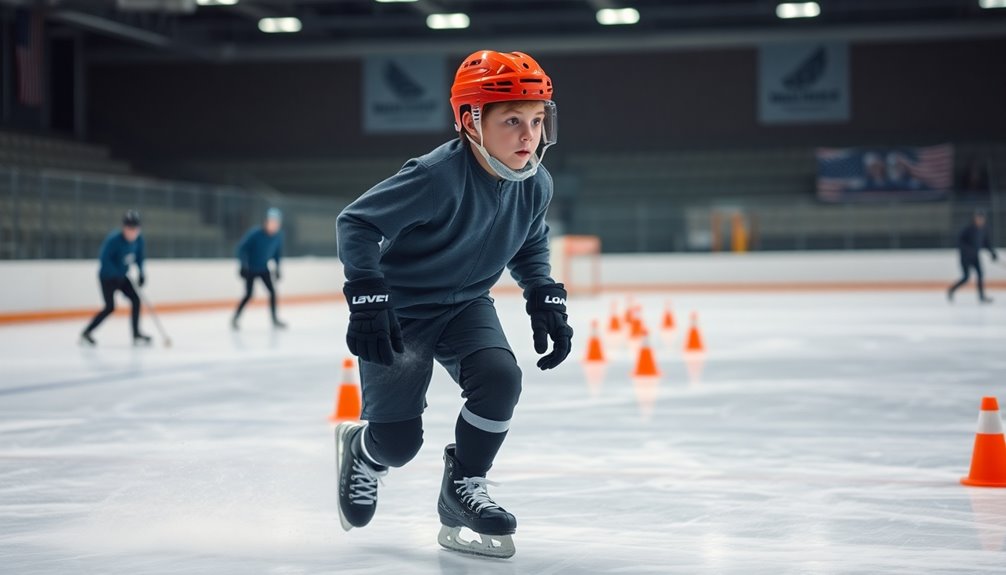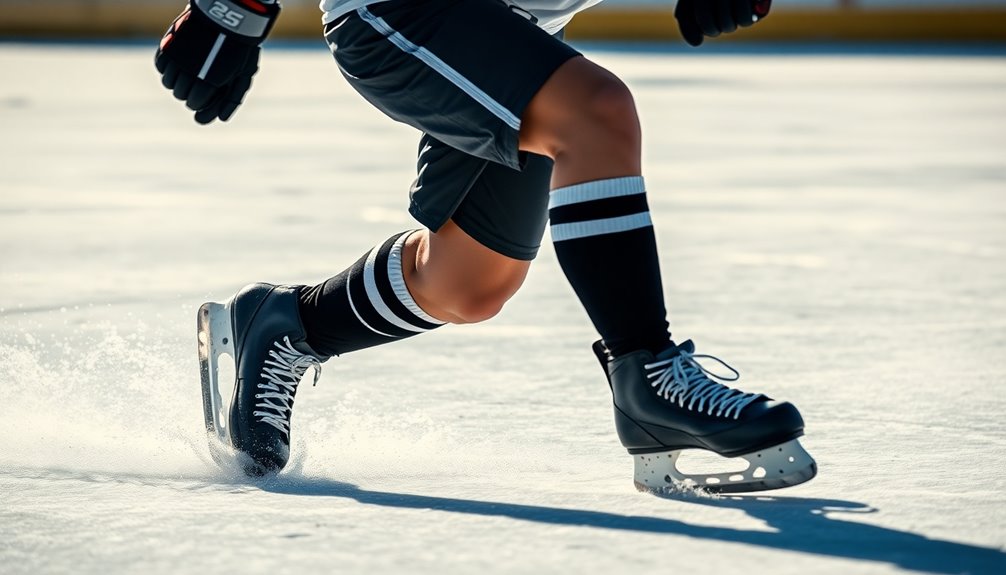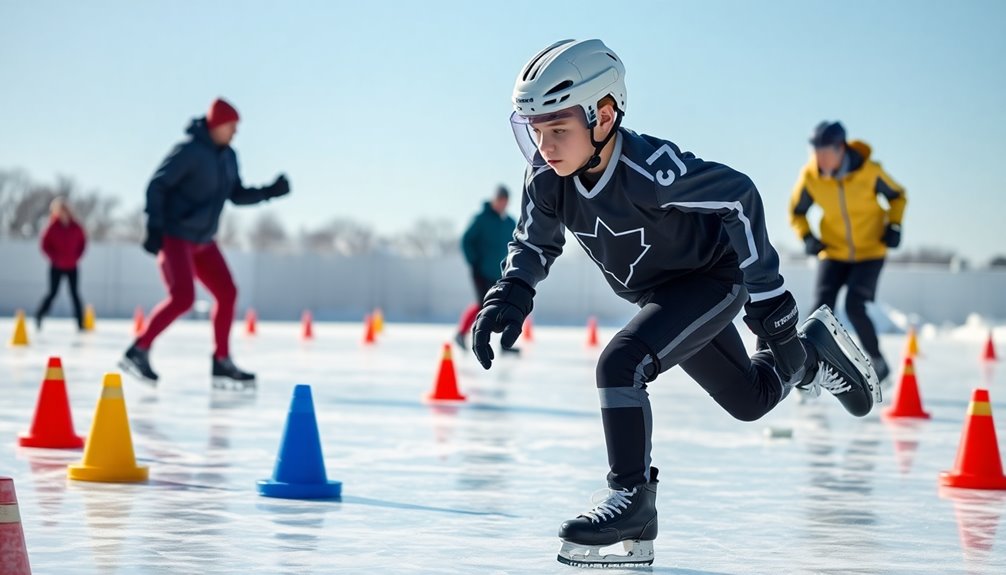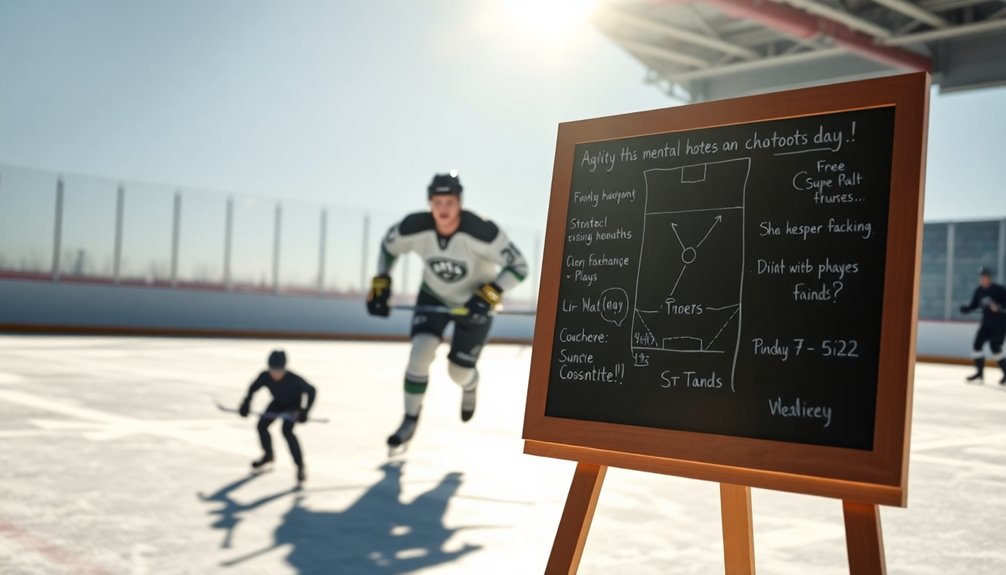
How to Become Faster and More Agile in Hockey
January 2, 2025To become faster and more agile in hockey, focus on speed and agility drills. Practice quick touch exercises to boost foot speed, and incorporate explosive crossovers for lateral movement. Conditioning is key, so balance aerobic and anaerobic workouts while including high-intensity interval training. Don't forget mental preparation—visualize plays and rehearse game scenarios to enhance your decision-making under pressure. A balanced diet and proper hydration will fuel your performance, while regular assessments help track your progress. Master these strategies, and you'll elevate your game on the ice. There's plenty more to explore to maximize your potential.
Importance of Speed in Hockey
Speed is the heartbeat of hockey; without it, players can struggle to keep up with the fast-paced game. To excel, you need to prioritize speed training as an essential element of your practice regimen. In lower tiers, fast players might shine, but when you hit higher levels, that speed can become average. You've got to stand out, and that's where dedicated speed training comes in.
Quick feet play an important role in enhancing your overall speed. Staying low in your hips and being light on your toes will greatly improve your agility on the ice. Heavy feet can slow you down and hinder your movement efficiency, while light feet allow for quicker, more agile responses during play. Incorporating agility and coordination workouts into your training can further enhance your performance on the ice. Agility drills such as cone drills and shuttle runs can significantly boost your ability to change direction quickly.
Incorporating speed training both on and off the ice is fundamental for your hockey performance. It influences your effectiveness in key game moments, such as breakaways and puck battles. Additionally, improving cardiovascular endurance through various training methods can significantly enhance your speed and agility during games.
Understanding Quick Feet and Agility
Understanding the importance of agility training can greatly enhance your performance, as it combines physical strength with quick decision-making. To improve your quick feet, you'll need to incorporate specific drills that challenge your athletic position and motor patterns. Additionally, incorporating dynamic stretches into your warm-up routine can help prepare your muscles for the demands of agility training. Engaging in agility drills can help you develop the necessary quickness and coordination for effective movement on the ice. Incorporating drills such as Pain Shuttles Drill can significantly boost your agility and endurance on the ice.
Quick Feet Definition
Many players often underestimate the importance of quick feet in hockey, which refers to the ability to move rapidly and efficiently on the ice. Quick feet focus on maintaining lightness on your toes and a low hip athletic position, enhancing your overall agility.
In hockey training, developing quick feet is essential for executing complex skating maneuvers and improving your on-ice performance. Quick feet drills refine your movement mechanics, promoting ideal postures that contribute to agility.
By training your quick feet, you enhance your kinaesthetic awareness and movement fluency, enabling you to make swift directional changes and react effectively to dynamic game situations. These drills are foundational for improving your agility and speed, as they equip you with the essential skills needed for more complex movements on the ice.
It's important to distinguish between quick feet and agility training. While quick feet drills specifically target foot speed and movement efficiency, agility encompasses cognitive elements like reading and reacting to plays.
Focusing on quick feet will give you the edge you need to maneuver effectively and elevate your game performance.
Agility Training Importance
Agility training is a game-changer for hockey players, as it greatly enhances your ability to navigate the ice with finesse. By focusing on developing quick feet, you can improve your agility, which is vital for making game-changing plays and winning puck battles.
Agility involves not just speed, but also your capacity to change direction quickly and efficiently, allowing you to react to the fast-paced nature of the game.
Key components of effective agility training include explosive strength and core strength. These elements work together to provide the foundation for rapid decision-making and kinesthetic body awareness, both essential for executing complex movements under pressure.
Remember, agility isn't just about physical capability; it's also about mental acuity. A layered approach to training will help you read the game better and react swiftly.
While you'll likely see gains in strength and power first, don't forget that improvements in agility require a long-term commitment.
As you dedicate time to agility training, you'll notice how much easier it becomes to maneuver on the ice, enhancing your overall performance and making you a more formidable player.
Drills for Improvement
How can you effectively enhance your quick feet and overall agility on the ice? Focus on specific drills for improvement that target foot speed and dynamic movement. Here are four essential quick feet drills to incorporate into your agility training:
- Two Foot Quick Touch: Maintain a low athletic position while rapidly tapping your feet in place. This drill emphasizes arm movement to enhance overall speed.
- Explosive Crossovers: Practice quick lateral crossovers, pushing off hard with each stride. This simulates game-like scenarios and boosts your agility.
- Lateral Quick Figure-8: Move side-to-side in a figure-8 pattern. This drill not only increases foot speed but also improves your ability to read and react on the ice.
- Linear Quick Feet Figure-8: Similar to the lateral drill, but focus on forward and backward movements. This helps refine your movement quality in various directions.
Always remember to keep the intensity high and assess your progress regularly.
Key Movement Mechanics

To achieve peak performance on the ice, mastering key movement mechanics is essential. Start by maintaining a low hip athletic position; this stance maximizes power expression and helps generate speed during your movements. Engaging your glutes effectively enhances the force produced in each stride, greatly boosting your overall speed and agility. Understanding the importance of defensive principles can further contribute to your agility on the ice. Additionally, effective defensive stances can improve your overall balance, allowing for quicker transitions and reaction times.
Regular self-assessment of your posture during drills is vital. By identifying and correcting inefficiencies in your movement mechanics, you'll see improved performance on the ice. Additionally, incorporating defensive stance drills into your training can enhance your agility and quickness on the ice, allowing for better transitions during gameplay.
Don't underestimate the importance of active arm movement; your arms play a critical role in balance and propulsion. When you synchronize your upper and lower body movements, you optimize your speed potential and execute rapid directional changes with ease.
Effective Quick Feet Drills
To develop your quick feet and agility, incorporate these effective drills into your training routine:
- Two Foot Quick Touch: Perform quick touches for 15-20 seconds, maintaining low hips and active arms. This enhances foot speed and agility. Regular practice of speed and agility drills is essential for improving overall game impact. Engaging in consistent practice will further solidify your skill development.
- Two Foot Crossover Quick Touch: Focus on linear crossovers while staying low. This drill improves your crossover skills, which are vital for effective skating. Regular feedback from a coach can help refine your technique.
- Explosive Crossovers: Engage in lateral movement drills that emphasize a low athletic position. This enhances your power and quickness when you need to change direction.
- Lateral Quick Figure-8: Navigate a figure-eight pattern using multi-directional movements. Emphasize staying low and light on your feet to boost your agility and footwork. Incorporating agility training into your routine can significantly enhance your movement and reaction time on the ice.
Agility Training Techniques

When you focus on agility training techniques, it's important to combine explosive strength with quick decision-making skills. Effective agility on the ice requires not just physical prowess but also the ability to make rapid changes of direction. Incorporate drills that challenge both your cognitive and physical pathways simultaneously; this layered approach helps optimize your responses in game-like scenarios. A strong commitment to quality training sessions can significantly enhance your overall agility and skill development.
Utilize hockey-specific agility drills, such as lateral movements and quick footwork patterns, to enhance your overall performance. These exercises won't only improve your speed but also enhance your body composition when you maintain high intensity throughout your training sessions. A strong aerobic base from cardio training is also essential for sustaining energy during intense skating sessions.
Don't forget to include core exercises, as a strong core is fundamental for stability during quick maneuvers. Engaging in speed, agility, and endurance workouts can significantly improve your reaction time and overall performance on the ice.
Regularly test and assess your agility to identify specific areas for improvement. Tailoring your training protocols to meet your individual needs is key for long-term success. Commit to sustained effort and continuous evaluation, as developing agility takes time and patience. Remember, mental preparedness is just as important as physical drills.
Stay focused and dedicated, and you'll see significant progress in your agility on the ice.
Conditioning for Enhanced Performance
Agility training lays a strong foundation for the next step: conditioning for enhanced performance.
To elevate your game, you need a well-rounded approach that focuses on both strength and agility. Incorporating high-intensity interval training (HIIT) into your regimen can greatly boost your speed and explosiveness on the ice.
Here are four key elements to include in your conditioning plan:
- Aerobic and Anaerobic Training: Balance your conditioning sessions to build endurance for long shifts and quick recovery between intense efforts.
- Strength Exercises: Focus on single-leg stability and core engagement to enhance overall agility and power in your skating movements.
- Agility Drills: Utilize drills like the 5-10-5 Pro Agility test to measure your speed and agility, tailoring your training protocols to your specific needs.
- Progress Assessment: Regularly evaluate your conditioning progress to adapt strategies and guarantee continuous improvement in cardiovascular fitness and movement efficiency.
Mental Strategies for Improvement

To boost your performance on the ice, focus on mental strategies that enhance your agility.
Visualization techniques can help you make quick decisions under pressure, while cognitive agility training sharpens your reaction times.
Visualization Techniques
Visualization techniques serve as powerful mental strategies that can greatly enhance your performance in hockey. By engaging in mental imagery, you can mentally rehearse movements and game scenarios, which can improve your reaction times and execution under pressure.
Here are some effective ways to incorporate visualization into your training:
- Pre-Game Visualization: Spend time before games imagining yourself successfully executing plays and making quick decisions.
- Practice Visualization: While you train, visualize your movements in detail. Picture yourself performing drills with agility and precision.
- Scenario Rehearsal: Create mental scenarios where you face challenges on the ice and visualize how you'll respond. This helps prepare you for real-game situations.
- Regular Sessions: Dedicate specific times to practice visualization, treating it as essential as physical training.
Research shows that athletes using these visualization techniques boost their confidence and focus, enhancing agility and overall performance.
Decision-Making Under Pressure
Mental preparation through visualization sets the stage for effective decision-making when the pressure is on. To enhance your decision-making under pressure, engage in mini-games and drills that mimic real-game scenarios. This practice sharpens your ability to think and react quickly, which is essential in high-stress situations.
Remember, quick decision-making can differ based on whether you're on the offensive or defensive, so tailor your drills accordingly.
Incorporating tools like BlazePod™ can also be beneficial. These tools help improve your reaction time and agility, allowing you to practice decision-making in a dynamic environment. As studies show, cognitive processing strategies play a significant role in influencing your response times.
Consequently, focus on mental agility through specific training routines. Additionally, try activities like chess to cultivate strategic thinking skills. This can enhance your ability to make quick decisions during games, ultimately improving your cognitive and physical agility on the ice.
Cognitive Agility Training
How can you enhance your cognitive agility on the ice? Cognitive agility training is essential for improving your decision-making and overall agility during games. Here are some effective strategies to reflect upon:
- Simulate Real-Game Scenarios: Engage in drills that mimic game situations. This helps you develop mental processing strategies and adapt quickly to chaotic environments.
- Incorporate Visualization Techniques: Spend time visualizing plays before they happen. This sharpens your mental preparedness and allows you to anticipate moves, leading to quicker reactions on the ice.
- Participate in Mini-Games: Play competitive drills that challenge both your physical and cognitive abilities. These mini-games enhance your perceptual-cognitive skills, improving your performance under pressure.
- Regularly Assess and Refine: Continuously evaluate your cognitive responses during practice. Fine-tuning your decision-making tactics can lead to noticeable improvements in your agility and effectiveness when it matters most.
Conclusion
In the fast-paced world of hockey, becoming faster and more agile isn't just important—it's essential for domination on the ice! By mastering quick feet and agility, you'll dart past opponents like a cheetah on rollerblades. With the right drills, conditioning, and mental strategies, you'll transform into a whirlwind, leaving defenders in your dust. So gear up, hit the ice, and release your inner speed demon—because the championship trophy is waiting for you to claim it!


